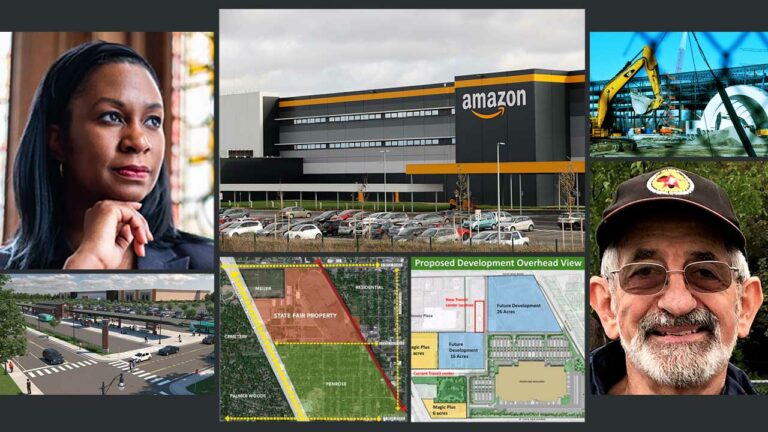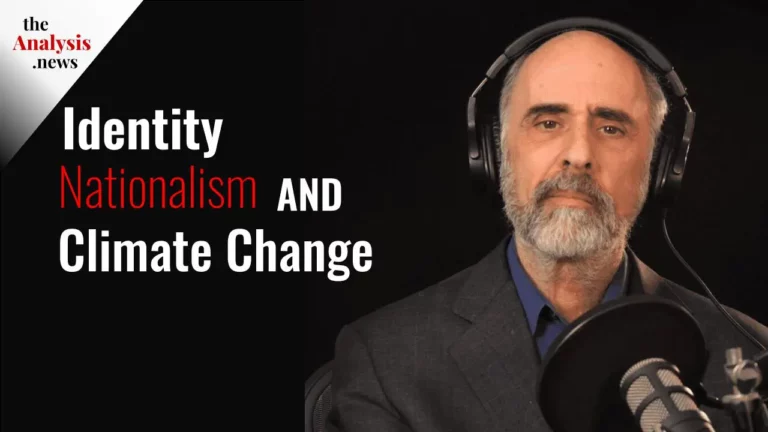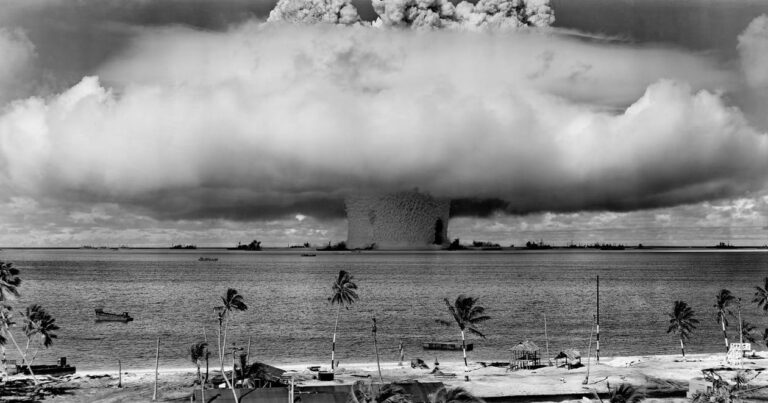What is to be Done to Save the Planet – Robert Pollin
Robert Pollin and Noam Chomsky’s new book is titled, The Climate Crisis and the Global Green New Deal: The Political Economy of Saving the Planet. In this segment, Bob lays out the policies that must be enacted in order to meet the targets set by the IPCC. Bob Pollin joins Paul Jay on theAnalysis.news podcast.
Transcript edited for clarity
Paul Jay
Hi, I’m Paul Jay. Welcome back to theAnalysis.news podcast and this will be part two of my interviews with Bob Pollin about his new book. Please join us.
So this is the continuation of our discussion on Bob Pollan’s new book that he co-wrote with Noam Chomsky. It’s titled “The Climate Crisis and the Global Green New Deal: The Political Economy of Saving the Planet.” And I suggest you watch or listen to part one because part 2 will make more sense.
So, Bob, let’s pick up where we left off and dig into the book. You go through various sources of greenhouse gases and policies that need to be created, legislation that needs to be passed, and regulations to deal with. So let’s just kind of go through some of them.
One of the big ones early in the book, and I’m going to quote from the book here, “Corporate industrial agriculture is a major driver of climate change, responsible for roughly 25 percent of total greenhouse gas emissions, including CO2, methane and nitrous oxide, the three main greenhouse gases.”
So I know this gets some play or focus for people that follow the story. But industrial agriculture isn’t kind of front and center for people’s consciousness when you think about climate change, and 25 percent is a hell of a lot.
So dig into the significance of corporate industrial agriculture, and what are the policies that should be developed?
Robert Pollin
Right. Well, when you say people haven’t focused on it and should, I’d have to include myself as guilty of not having focused on it adequately up until now. By doing the book with Noam, I thought it’s about time myself, and I started to give this much more attention than I have in my previous work. Because it’s not the majority of greenhouse gases, but 25 percent is a considerable amount.
Fortunately, I think we can address the problems generated by industrial agriculture in very straightforward ways. You can break it down into two sources of emissions and expansion of emissions and loss of absorption of emissions.
One is deforestation. So we do hear a lot about deforestation, but we don’t hear too much about the magnitude and the role of deforestation. According to the IPCC, which is not their research, they summarize other people. If we say 25 percent is industrial agriculture, about half of that is due to deforestation. So we’ve got to stop deforestation, and we’ve got to engage in reforestation. That means defending the Amazon rain forests, and we need to stop destroying it, start reforestation, and then create work and opportunities for people that live in that region. So that’s half of the 25 percent.
The other half of the 25 percent comes from industrial agriculture. Heavy agriculture involves the use of nitrogen fertilizer to increase productivity from farming. The industrial agriculture model based on monoculture crops, heavy nitrogen fertilizer, and hefty investments in irrigation has shown a growing food supply. Still, it also releases greenhouse gases and as well as contaminates the water and soil. So if we transition out of industrial agriculture and into organic agriculture, you start to absorb greenhouse gases. You do not release greenhouse gases as you would with nitrogen fertilizer, which releases CO2 and methane. That’s the way that you address the 25 percent.
Now, there’s a debate in the literature, and again, I’m no expert in the literature, but I read it. I think it’s fair to say that on balance, you will reduce food productivity by, say, five to ten percent by moving to organic agriculture. So what do we do? We need to increase food supply, not reduce food supply. Number one, we have to reduce the extent to which we rely on slaughtering cattle as a source of the food supply. Whether or not you think it’s immoral to kill cattle, which we can talk about in any case, it requires enormous amounts of land, which you can replace with growing crops or even replacing with other animal products, such as chickens and pigs, which require far less land. So we do need to reduce our requirements for cattle, hamburgers.
Paul Jay
In the book, you say, “the global population of cows and bulls is about 1.5 billion, far greater than other ruminants. The cows are responsible for about 2 billion tonnes of greenhouse gas per year through their methane emissions. And this alone amounts to about four percent of total greenhouse gas emissions as of 2018.”
Although I have to say I saw a YouTube video, I don’t know if it’s just a joke or not, but maybe that is one place you could have carbon capture and methane capture. They put bags on the asses of cows, and they farted into the bags. I don’t think that’s very practical with 1.5 billion cows.
Robert Pollin
Let’s change our diet, even modestly. On top of that, the level of food wastage is gigantic. Forty percent of the food that’s produced is wasted, both in developing countries and in rich countries. They’re wasted for different reasons. In developing countries, 40 percent is wasted because the storage capacity is inadequate. So what do we have to do? We invest in improving storage capacity. In rich countries, 40 percent is wasted because we order food from restaurants, and it gets wasted. So what we need to do is just think about even modestly, reducing the level of wastage. If you do that and even modestly, cutting back on our consumption of cattle, we will be able to transition easily into an organic agriculture dominant system. This will enable us to absorb CO2 and not expend CO2 with fertilizer and therefore get to that, roughly 12 percent of emissions that are due to industrial agriculture.
Paul Jay
It seems there is a public appetite to some extent for this. There is the Beyond Meat Burger option. I know there’s some debate on the ingredients in the Beyond Meat Burger and similar types of products. Even in some of the fast-food outlets, you’re starting to see grass-fed cattle. If it is going to be beef, you’re starting to see an appetite for an organic kind of diet. So maybe the politics of this are not as challenging to accomplish as fossil fuel politics.
Robert Pollin
Yeah, it’s straightforward. We don’t want to exaggerate it. I’ve heard people say the problem of climate change is caused because of cows farting. That’s about four percent of the problem. So let’s not say it’s 100 percent. Let’s say it’s four percent.
Paul Jay
Maybe I should have focused more on deforestation because you could have a very similar issue in terms of just transition for forestry workers. I don’t think deforestation means the end of cutting down trees. But doesn’t it also mean; planting massive amounts of new trees and I can’t see why the public wouldn’t support such a thing?
Robert Pollin
Well, I think we do have to stop cutting trees to the extent we’re doing. There has been some progress. We need to stabilize within 30 years or less because when you chop down trees, it releases CO2. Trees store CO2, and then you also lose the capacity of those trees to absorb CO2. Now you can say the trees will grow back, and then they will begin to absorb again. That’s true. But it’ll take 30 years for the trees to get up to where they’re 30 or 40 years. To get up to where they were absorbing, as they had been when the previous ones were chopped down.
The main reason that trees are chopped down is to create more land for cattle farming. So if we cut back on the need for cattle farming, we can also release the pressure to chop down the trees and prevent deforestation in the Amazon and elsewhere.
Paul Jay
So if we go back to the issue of sustainable energy, you’ve said that sustainable energy like wind and solar, the price point for this technology is now competitive with fossil fuel. In some cases, it’s even cheaper. Why isn’t it growing faster? Why isn’t it a more significant part of the overall energy picture? Because if I understand correctly, is it not less than ten percent of energy production now.
Robert Pollin
Oh, it’s much less. If we take solar and wind globally, it’s maybe two percent: of which wind is 1.5 percent and solar is 0.5 percent. So it’s minuscule.
That said, if we look at the global evidence on cost, on average, solar is, to quote some numbers, solar is at 6.8 cents per kilowatt-hour of electricity and wind is 5.3. Whereas with fossil fuels, they range between 5.8 and 17.7 cents. This is data from the International Renewable Energy Agency (IRENA). If we look at the evidence from the US Energy Department, the Trump Energy Department, the numbers are the same.
So why don’t we just have this transition to these cheaper forms of energy? Well, because they’re not there. You have to get over the hump. You have to invest. Otherwise, you don’t get clean energy. So there’s a lot of inertia built-in, and there is uncertainty. People already know how to make money off of fossil fuels, especially oil companies. So what we need to do is clamp down on fossil fuel energy, subsidize clean energy, and make it easy for public investors and private investors to start building it up fast.
If you make it hard and expensive to expand fossil fuel energies and easy and cheap for clean energy, things will move in that direction.
Paul Jay
But you’re also calling for a big public investment in sustainable energy.
Robert Pollin
Oh, yeah. When I say investment, I don’t just mean private; I do mean some private. But look, let’s start with the public investment. Globally, as we talk about in the book, it’s roughly 50/50, 50 percent public, 50 percent private. The 50 percent public is the leading edge. It helps to create the market to make it viable for private. We need the regulations in place to make it very difficult to sustain fossil fuels in private.
In other words, you need to cut utilities, you need to cut your fossil fuel investment by five percent a year, or else you go to jail. You need to say automobiles need to be 100 percent clean electric vehicles in 15 years. The state of California has already said that, and as well in Europe. You need to say to invest in public transportation. You need to say for industrial agriculture; we have to do combined heat and power to stop wasting energy at the industrial sites. These are the various things that need to be done. You need to build up heat pumps in buildings and industrial activity, which cuts energy consumption by 40-50 percent. These are the things that need to happen. They’re not hard to happen, but they need to be incentivized.
Paul Jay
Now, one of the things Biden says clearly is that he’s for eliminating fossil fuel subsidies. Has he said it clearly that he’ll do it, or is he saying he wants to do it, but he’s only going to do it if China and other countries do it?
Robert Pollin
I think he wavers. By the way, even if we eliminate fossil fuel subsidies in the United States, that’s not enough. You need to stop them. You need to make it illegal to burn fossil fuels. So even to say we’re going to eliminate fossil fuel subsidies or maybe we’re going to eliminate fossil fuel subsidies. That’s a step in the right direction, but it’s not enough.
There’s also a problem with that. In the US and even more so in the rest of the world, fossil fuel subsidies do get translated down to lower energy costs for working people and the poor. Even in the US, fossil fuel subsidies are large subsidies for farmers, enabling them to charge less for food. So unless we have a way to translate the fossil fuel subsidies into clean energy subsidies, it will mean higher food prices, which we don’t want. That’s even more emphatic in low-income countries.
The main thing we can’t do when we eliminate any subsidy is allow it to become the burden of the working-class people and the poor.
What happened in France? They said we’re going to jack up fossil fuel costs through the carbon tax, and we’re going to make it expensive to buy fossil fuel energy: oil, coal, and natural gas. That’s what started in 2019, the so-called yellow vest movement, a mass movement against the carbon tax. Macron, the neo-liberal president, says, well, you don’t care about saving the planet, and I do. The yellow-vest people say we care about saving the planet, but we also care about affording food and turning on our house lights.
The Green New Deal has to be laser-focused on the distributional impacts of any clean energy project. When we advance a clean energy project, it is also an egalitarian project that creates jobs and raises living standards for workers and the poor. Not lowers living standards.
Paul Jay
What’s your take on carbon tax because it’s been critiqued that it’s a market mechanism and it’s too slow. It just can’t deal with the urgency of the situation, and it’s unfair, as you were saying.
Robert Pollin
The carbon tax can work. Jack up the price of gas in a car to 30 or 40 dollars; nobody will be able to afford it. The problem is people’s living standards go down. The carbon tax can work as part of an overall project. The carbon tax can discourage people from buying oil, petroleum, natural gas to heat their homes and substitute clean energy. Some of the revenue can then go into investing in building up solar and wind in high efficiency. But it’s not going to work on its own. When you raise the tax, you have to be sure that most of the money is going right back into the pockets of working-class people, middle-class people, and the poor.
For example, in the book, we talk about distributing revenue globally. Specifically, a global carbon tax in which 75 percent of all the revenues are distributed equally to every single person in the world. Everybody gets sixty dollars. Sixty dollars means nothing for a middle-class person in the United States, but for an average household in Kenya of, let’s say, four people, that is 250 dollars. That is equal to five to ten percent of their overall annual income. That’s real. Therefore the carbon tax with redistribution can be a useful tool.
Paul Jay
You talk about the need for industrial policies. What does that mean?
Robert Pollin
Industrial policies, more or less, what we’re talking about is having a program to subsidize and finance clean energy investments at a magnitude that reflects the urgency of the problem. In other words, if you’re in government, if you’re private, or if you’re a co-op, you can get clean energy investments for next to nothing. You want to borrow a million dollars and invest in putting solar panels in your factory; you’re going to get it at zero interest. That’s a big part of industrial policy.
The other part is that we have to shut down the fossil fuel industry. We have to say cut fossil fuels; you’re a utility, you want to keep existing, you don’t want to go to jail? Well, figure out whatever you’re producing annually in burning coal or natural gas; next year, cut it by five percent and so forth. If you do the simple math on that, you’ll be down to zero in 20 years.
Paul Jay
The funding of this. You talk about transferring funds out of military budgets, green bond funding by the Federal Reserve. This is funding for this investment in sustainable energy, which just transitioned into the various other parts of the program. You’ve done a lot of the math on this. The Republicans say this is unaffordable that this is all going to cost too much.
Robert Pollin
It’s actually going to cost very little. I wish we could get some of the mainstream Democrats to see these simple points. Whenever you talk about any costs, you have to think about it from a broader perspective. Any investment in anything costs money upfront. The whole point with the Clean Energy Project is that once you do the investments, like with any investment, over time, you save money. Otherwise, you wouldn’t do it.
If capitalists thought they would do an upfront spending of money and then not make it back in profits, nobody would ever invest in anything.
What is evident with the clean energy investments we’re already at cost parity. To build and invest in solar and wind, the cost of delivering a unit of energy to a household is equal to or less than fossil fuels. Secondly, raising efficiency saves money.
So, yes, you have to make the upfront investment, and then it’s cheaper. Even the upfront investments, if people are talking about investing in fracking, why not invest instead in clean energy? If the regulatory structure tells us, you can’t keep investing in fracking, you can’t keep investing in oil, invest in clean energy, it will be done, and over time, it will be cheaper—all that in addition to saving the planet.
Paul Jay
Let’s talk about some other issues that get debated often. One is the idea of less growth. I guess it’s called the Degrowth Movement. Michael Moore’s film that he executively produced was the most recent version of that. You’ve been debating this for years. What’s your take on it?
Robert Pollin
Well, I want to preface, I don’t consider the degrowth proponents the enemy. I respect what they’re about. I share most of their values. If you strip away a lot of the rhetoric, what we’re talking about is almost the same thing. So that’s my first point. The idea of degrowth is overly simplistic. When it gets to really focusing on the solutions to climate change, it’s just wrong.
Growing less in a very broad, sweeping sense gets us nowhere. What we’re talking about in terms of building a new energy infrastructure: global, clean, zero-emissions, energy structure, means massive, gigantic growth, not degrowth, growth of solar, wind, and efficiency. That’s what we’re saying. Huge growth. As we talked about just a couple of minutes ago. Right now, clean energy, solar, and wind, in particular, are maybe only 1.5 percent of the overall energy supplied globally. If we want that to be 50 to 60 percent, within ten years, that is a massive growth project.
Yes, we want to have a degrowth of fossil fuels down to zero. So degrowth of fossil fuels and massive growth of clean energy. The whole notion of sweeping overall degrowth doesn’t get us anywhere. If you do the simple arithmetic, and if you say we’re going to stabilize the climate through degrowth, it also brings us nowhere. Right now, global emissions of CO2 are at 33 billion tons. If we cut economic activity by 10 percent, which is twice the level of contraction that we’ve already experienced this year due to the COVID crisis, a 10 percent economic depression will mean a 10 percent cut in emissions. Unless we change the energy structure, it just doesn’t work. Again, I like the people. I support a lot of what they’re thinking about. It just doesn’t work. We need to get beyond that debate and focus on the things we want to see grow, such as clean energy and efficiency, reforestation, and organic agriculture. And the things that we want to see contract: fossil fuels, chopping down forests, and industrial agriculture.
Paul Jay
The issue of carbon capture, your critique of the Biden plan, is that it’s so reliant on it. But is there something to it? Is it a technology that does need to be invested in for investigated research as part of an overall plan?
Robert Pollin
There are two types of carbon capture. One is carbon capture and sequestration. So we have this capacity when we burn oil, coal, and natural gas that we take the carbon and turn it into liquid form. Then you have these pipelines that store it underground forever. There’s really no point in doing this. It is a massive project. Anyway, it’s not safe, storing it underground forever? Who knows what is going to happen.
The other way to think about carbon capture is to capture the carbon and you convert it into energy (liquid fuels). There’s some possibility of that having some role, but that technology is nowhere in sight. Even the people, the biggest supporters of it, say, well, we don’t know, it may work in 20 years, it may work in 30 years, it may not work at all. So I wouldn’t say we shut it out entirely. However, I would say it is a speculative technology that could be used in 20 to 30 years.
In the meantime, we already have technologies that we know work. We already know solar and wind work. We already know that reforestation absorbs CO2. We already know organic agriculture works. These are what we could call low tech solutions and low-cost solutions. If they’re not 100 percent of the solution to zero emissions, they will be 90 percent, 85 percent, or 95 percent of the solution. Maybe in 20 years, carbon capture with reuse can be another five, six, seven percent of the solution.
Paul Jay
So the thing that’s been bugging me about this whole thing for a long time is how the elites, who have the power to do something about this, don’t see it in their interest to do something. If you combine the Nordhaus example that we talked about earlier, the economist who won the Nobel Prize and thinks getting to four degrees is optimal, which according to him, will likely not happen until the next century. That means there’s lots of time to develop geoengineering technology that will suck all the carbon out of the air to stabilize at four degrees or less, according to these guys.
So maybe that explains why there’s not this sense of urgency in the elites to do something about it; between four degrees and another 70 to 90 years to develop geoengineering, they might be thinking why should I worry?
Robert Pollin
Yeah, that’s probably at the root of it. Again, like carbon capture and geoengineering, for example, injecting aerosol into the atmosphere that will help deflect sun rays. Similar to what happens when you have a volcano that releases aerosol into the atmosphere. We know that it has achieved some small degree of cooling right after a massive eruption. That’s kind of the model that they have in mind. We’re nowhere close to knowing whether this can work on a global scale and, even if it does work, whether there are any adverse side effects. So that’s all at the level of speculation.
If you follow William Nordhaus, as you just were talking about, the 2018 Nobel laureate, he says four degrees is optimal in 2150, but he does also say we can get to two degrees warming by 2050 in 30 years. The Intergovernmental Panel on Climate Change already rejected it. That was the point of their 2018 report, which said we couldn’t count on two degrees anymore. Climate science doesn’t allow that; we have to be at 1.5. Nordhaus was openly ignoring; he is not a stupid person. But he was openly ignoring what the IPCC had come out with merely two months before his own Nobel Prize lecture. Nordhaus says, let’s get to two degrees by 2050 and four degrees by 2051. That’s our optimal path. That is brazenly neglecting what the premier organization studying climate science is saying is necessary to stabilize.
If the elites are saying, William Nordhaus says we could do this. He’s a Nobel Prize winner. Who’s to argue with a Nobel Prize winner? That could be behind it.
Paul Jay
Even those estimations of the IPCC, later reports have come out; I quoted this in an interview we did earlier, but I’ll do it again because I think the numbers are so significant. The 2019 UN annual emissions gap report states that “if all the countries that made commitments to the Paris agreement fulfilled those promises completely, we’re still headed for two degrees warming by 2050 and three degrees by the end of the century”. Now I’ll repeat it if Paris objectives are fully met, we hit almost unlivable conditions in 30 years and a catastrophic tipping point in 80; within the lifetime of our kids. These assessments were based on all countries meeting the Paris agreements, which we know isn’t happening.
If Trump is re-elected, what we’re looking at by the end of the century, is Trump getting re-elected and nothing changing on a global scale in terms of how countries are responding to this. The IPCC says that by the end of the century, we’re getting to 4.8 degrees, not the four that Nordhaus is talking about.
The Independent reported that the IPCC estimate might be low. Quote, “research by an international team of experts who looked into how the Earth’s climate has reacted over the last 800,000 years, warns this could be a major underestimate. They believe the climate is more sensitive to greenhouse gases when it’s warmer. The actual range could be 4.78 centigrade to 7.36 by 2100, based on one set of calculations. These calculations are by scientists that are part of the IPCC.
So if we’re not taking action now, never mind four degrees is insane anyway, that it’s optimal, but it may not be four; it may be over seven, which means most of the Earth isn’t livable.
The IPCC 2018 estimate was alarming enough. It was extremely alarmist in terms of where we are and what climate scientists are saying we have to do. They said to get to a 50 degree CO2 emission or 45 degrees in nine years and net zero in 29 years. Now let’s say they’re even wrong. Let’s say this is an underestimate. That’s where we really have to focus. All that they are getting to a zero-emissions path is easily achievable analytically in terms of the financing.
We simply have to take the people like Nordhaus and just say we can’t gamble that you’re right. We can’t play Russian Roulette on the destruction of life on Earth as we know it. Alternatively, advancing a Green New Deal that gets us to zero in 25 years or less is achievable. It will expand job opportunities. It can raise living standards. We build in a just transition for people and communities that are already dependent on fossil fuels. It’s a program that is easily attainable. If we’re thinking about it just logically and in terms of economics and financing, all of it is easily attainable.
What’s needed, of course, is the political will. The movement to fight for it. The development that I’ve seen and have been a part of in a small way in the last few years is that people in the labor movement in the US and elsewhere are joining forces with environmentalists and others to advance this project. I think once we have the labor movement and the environmental movement on the same page, we’re going to make progress in a serious way within the United States under a Democratic administration. At least that’s the plan.
Paul Jay
All right. Thanks very much for joining us.
Robert Pollin
I appreciate the opportunity.
Paul Jay
And thank you for joining us on theAnalysis.news podcast. And don’t forget the donate button at the top of the webpage.
Podcast: Play in new window | Download







Very simple things to do: STOP eating meat, with no buyers the corporate agribusiness will cease to exist.
Buy ONLY organic and support CSA farmers, stop buying plastic junk.
Are we wiling to walk the talk or just talk-talk-talk. No law will bring any change unless people change.
Note: Planet Earth knows how to save her self, do not pretend that you know how, just say: To save our ass!
apologies for the aggressive language,
Be well and stay calm.
1. I would stop eating meat if the fishermen would stop destroying the fish, and the polluters would stop destroying the world’s fish nurseries. Like most mammals, I have to get my protein from outside, and cannibalism is frowned upon, though I have never tried it. Nuts are fine, but they are constipating.
2. “The New Deal” is a popular expression on the left. It has lost its sting-value for the right. The days of Nye, Fish, Flynn, et al are long past. What is also long past is the understanding the FDR’s program was a save capitalism strategy. When it began to succeed, FDR cut back on it (1938). The US slipped back into depression until the our great, not entirely patriotic war began. FDR has not lasted in my mind as a heroic politician; only a skillful one who did what he saw he had to do. He did some awful things, such as embargo arms to the Spanish Republic to please the Catholic Church, turn back the ship of Jews to NAZI Germany to please our anti-Jew State Department, continue to develop the A-bomb after it was known that Germany was not in competition, imprison the Nisei, foster the US Grand Strategy plan. He was a banker, from a family of bankers. What could one expect! Forget the New Deal. We need a total political and social transformation!
It’s too late, anyhow! Enjoy yourself; it’s later than you think!